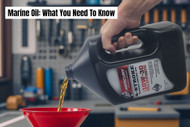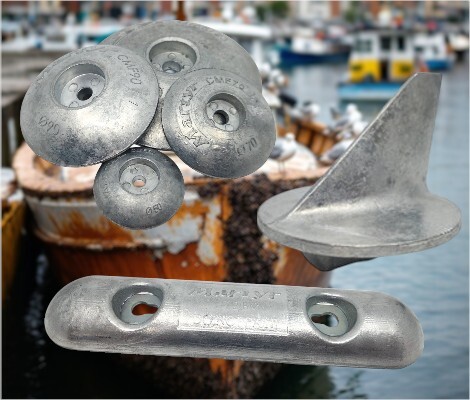Marine Oil: What You Need to Know
2nd Aug 2025
Maintaining a healthy marine engine starts with using the right oil. Whether you're cruising the Gold Coast or tackling offshore adventures, marine oil plays a vital role in protecting your engine from corrosion, wear, and performance issues. In this article, we break down the essentials of marine oil, how it differs from automotive oil, and how to choose the best type for your vessel.
Why Marine Oil Matters
Marine engines operate under different conditions than automotive engines—running at higher loads, for longer periods, and often in salty, humid environments. This places more stress on engine components, making high-quality oil absolutely essential. Marine oil is specifically formulated to handle water exposure, prevent corrosion, and protect against high engine temperatures and deposits.
Types of Marine Oil
2-Stroke vs. 4-Stroke Marine Oil
- 2-Stroke Oil: Used in older outboards or smaller engines, it mixes with fuel and requires regular top-ups.
- 4-Stroke Oil: More common in modern outboards and inboard engines. It circulates separately from the fuel and must be changed periodically.
Mineral vs. Synthetic
- Mineral Oil: Cost-effective and suitable for standard use or older engines.
- Synthetic Oil: Offers superior performance, thermal stability, and protection. Ideal for high-performance or commercial engines.
Browse our full range of marine oils.
Choosing the Right Marine Oil
Always refer to your engine manufacturer’s specifications. Look for oils that meet NMMA (National Marine Manufacturers Association) standards like FC-W® or TC-W3®, which certify marine-specific performance. Key factors to consider include:
- Engine type (2-stroke or 4-stroke)
- Manufacturer recommendations (e.g. Yamaha, Mercury, Suzuki)
- Usage environment (saltwater vs. freshwater)
- Operating conditions (recreational or commercial)
Oil Change Intervals and Maintenance
Regular oil changes are critical. For 4-stroke engines, it’s generally recommended to change the oil:
- After the first 20 hours (new engine break-in)
- Every 100 hours or once per season
- After prolonged storage or heavy use
Always replace the oil filter at the same time and dispose of used oil responsibly at a certified disposal site.
Signs You Need to Change Your Oil
- Engine is running louder or rougher
- Noticeable drop in performance or fuel efficiency
- Oil looks milky (a sign of water contamination)
- Dark, thick oil or sludge on the dipstick
Don’t wait for problems—proactive oil maintenance saves you money in the long run.
Best Marine Oil Brands to Consider
At Boaters World, we stock premium marine oils including:
- Mercury Quicksilver
- Cummins Valvoline
- Volvo Penta
- Sierra
- Yanmar
- CAT
- Anglomoil
- Yamalube
These brands are trusted by OEM manufacturers and meet all marine-grade standards.
Seasonal Considerations for Marine Oil Use
In Australia, boating conditions shift with the seasons—from long summer runs to colder, infrequent winter usage. During off-season storage, marine oil plays an important role in protecting engine internals from moisture buildup and corrosion. Before storing your boat, perform a full oil change and run the engine briefly to circulate fresh oil. This coats engine components and prevents oxidation over the winter months.
Mixing Oil for 2-Stroke Engines
For 2-stroke engines, oil is mixed directly with the fuel at a specific ratio (usually 50:1, but always confirm your engine’s manual). Using too little oil can lead to overheating and piston scuffing, while too much oil causes excessive smoke and carbon build-up. Pre-mixed oils that are TC-W3 certified are best suited for reliable, clean-burning performance in 2-stroke marine applications.
Oil Viscosity and Temperature Ratings
Just like in cars, marine engine oil comes with viscosity ratings such as SAE 10W-30 or 25W-40. These ratings determine how the oil flows at low and high temperatures. In warmer Australian waters, a higher viscosity oil (like 25W-40) may provide better engine protection during extended runs or high-load conditions. Always match the viscosity to your operating environment and engine load.
Understanding Oil Additives
Marine oils often include special additive packages—such as anti-foaming agents, dispersants, and detergents—to prevent sludge buildup and improve longevity. These additives help stabilise oil over long periods and protect against the harsh marine environment. While budget oils may seem appealing, they often lack the advanced chemistry found in premium marine oils.
Common Mistakes to Avoid
One of the most frequent mistakes boat owners make is using leftover automotive oil or skipping seasonal changes altogether. Another is overlooking the oil filter, which can lead to premature clogging and circulation issues. Be sure to inspect both oil and filter at regular intervals, and avoid mixing oil types (e.g., mineral and synthetic), as this can dilute protective properties.
FAQs
What’s the difference between marine oil and car engine oil?
Marine oil contains corrosion inhibitors and is specifically designed to withstand the high moisture, salt, and extended running conditions of marine environments.
Can I use synthetic oil in a marine engine?
Yes, as long as it meets your engine’s specifications. Synthetic oil often provides better protection and efficiency, especially in high-performance or heavy-use engines.
How often should I check my marine oil?
Check your oil level before every trip, especially if you're running long distances. Always inspect the colour and consistency as well.
What happens if I use the wrong type of marine oil?
Using incorrect oil can lead to premature wear, reduced performance, or even engine failure. Always follow your engine manual.

 Australian Dollars
Australian Dollars


